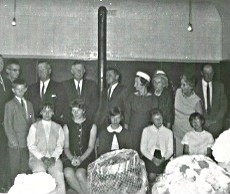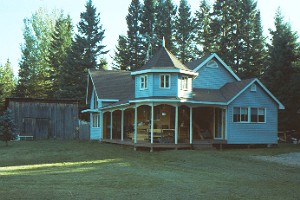|
Return to the Wharncliffe Main Page
Church Halls Pioneers Wharncliffe's Industries Transportation and Communication |
Little is known about the original school in Wharncliffe, that once stood at the top of Palmer's hill. However it is understood that William Pugh did foundation work involved in this school and all the neighbors took part in building it. It was placed in a location that would be convenient to all the people of the valley. The old school was used until 1910 when the north part of the valley was settled and the steel bridge was built across Mississagi River. At this time, after many meetings, it was decided to relocate the school.
Charles M. Ansley was generous enough to donate an acre of land for the reconstruction of the school. The old school was carefully dismantled and then rebuilt on an acre of land in the north east corner of the field. Next, rooms were built onto the school and a woodshed was built around back for storage of the wood that was used in the box stove heater. This was located at the rear of the classroom. It was now considered to be the "new" school. A pupil was chosen to tend to the stove for ten cents a morning and sometimes in the afternoon. This person also shoveled snow and swept the floor of the school when necessary. This all had to be done by 8:30 because school started at 9:00. There was a blackboard that extended across the entire front of the room and was well lighted by windows on both sides. There was also a small library in a large handmade bookcase in the corner next to the blackboard. It contained 120 books, mostly about history, geography, and important people. At this time if you were caught writing with your left hand, you would get the strap right across the hand. One student recalls that this was a common practice in the classroom. This changed after a while. One student remembers that square dances were held surreptitiously - although dancing was not allowed in the school - whenever the teacher left the building. When her footsteps were heard coming up onto the step, everything stopped and it was like a regular classroom again. A kazoo was used to make the music to dance to. Skipping school was also a prank to pull. One of the students remembers playing hooky one day and sitting up in a tree near the school. When he saw everyone run out of the classroom door for recess, he thought that school was out. But to his surprise his classmates did not begin to walk home, but instead continued to play around the school yard enjoying their lunch recess. The teacher and most of the students believed that this person was sick for the day. Trees were planted every spring around the school yard, and in June, just before school was out, the wild strawberries would be just ready to be picked and eaten from around the school ground. At this time all of the kids could be seen bent over picking strawberries. In the winter a skating rink was made off to the right of the school. The kids were grateful for this opportunity for a new recreational activity. One student recalls having a victory garden at the school during the war. Each student would have his or her own little plot to take care of. During the months of summer they would have to go over to the school and pull the weeds and continue to take proper care of their individual plots. Christmas concerts were also arranged. Practices started in November and were held in the Church. A bell was built on the peak of the roof and could be heard all throughout the valley. The bell was used until 1960 on September 26, at which time the pupils were taken by bus to a consolidation school in Little Rapids. Some of the people that went to school at this building had to walk a fair distance. Some had to walk a distance of 4 miles only to arrive at a building that was just beginning to warm up. For some it wasn't easy to get an education. The new school was used for political meetings and dances and on voting days . The school was in operation for 50 years and was at one point a hall, transformed by the Wharncliffe Women's Institute. They named it "Hazel Hall" after a deceased loved one and fellow member of the institute, Hazel Palmer. It is now a home.
Return to top |
Home | Natural Environment | History | Industry | Personalities/Stories | Credits/Team


